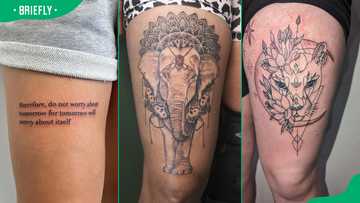What is the meaning of Celtic knots? A quick guide
Celtic knots (Irish: Snaidhm Cheilte) are a collection of decorative knots and stylised graphical representations of knots that are widely utilised in the Celtic style of Insular art. They are best recognised for their use as adornment on Christian monuments and manuscripts, such as the Book of Kells and the Lindisfarne Gospels. But what is the meaning of Celtic knots?

Source: Getty Images
TABLE OF CONTENTS
A Celtic knot is a symbolic pattern of a looped knot with no beginning or end. The cyclic pattern continues indefinitely. This article will explain the meaning of Celtic knots, explore their symbolism, and address some often-asked questions.
What is the meaning of Celtic knots?
At its core, a Celtic knot represents interconnectedness and eternity. With no beginning or end, these intricate patterns symbolise the infinite cycles of life, death, and rebirth. The knots are often associated with spiritual protection, unity, and the unbreakable bonds of love or friendship.
History of Celtic knots
According to Artin Context, knot art existed from at least 3000 BCE, long before the development of Celtic culture. However, Celtic Titles states that the first patterns were found in Roman floor mosaics in the third and fourth centuries AD.
It was also shown in Celtic art before Christianity influenced Celtic culture. From 450 AD onwards, knot motifs started to emerge in religious manuscripts and art. The Book of Kells stands as a notable example, showcasing a wealth of intricate, interlaced Celtic Knots.

Source: Original
Similarly, Insular artwork is prominently featured in the Lindisfarne Gospels, created between 715 and 720 AD. The earliest known instance of such designs appears in a fragment of a 7th-century Gospel Book, now housed in the library of Durham Cathedral.
The evolution and influence of knot motifs
Evidence shows that the designs were also featured in Byzantine, Ethiopian, Russian, and Islamic art and architecture. Today, Celtic knot tattoos, jewellery, and decorative pieces are cherished for their enduring beauty and profound symbolism.
Types of Celtic knots and their meanings
Celtic knotwork comes in various designs, each with its own meaning and significance. Here are some of the most popular types of Celtic knots:
1. Trinity knot
The trinity knot, also known as the triquetra, is among the most recognisable Celtic designs. It consists of three corners forming a triangular shape.

Source: UGC
Some variations incorporate a circle into the design, often symbolising life's triads: life, death, and rebirth, or past, present, and future. For Christians, it represents the Holy Trinity: the Father, the Son, and the Holy Spirit.
What does the trinity knot mean for a woman?
According to study.com, it represents the connection between mother, maiden, and crone. It may also represent the unity of life's physical, mental, and spiritual aspects.
2. Celtic cross
The Celtic cross, also known as the Irish cross, is a crucifix with a circle behind the four points of the cross, forming four semi-circles. It is commonly attributed to Saint Patrick.

Source: Instagram
There is evidence that it was also utilised in Celtic culture prior to Christian influence. As a result, the cross has both religious and secular meanings and is a popular tattoo design.
3. Celtic shield knot
The Celtic shield knot consists of a circle with four quadrants and interwoven lines connecting each of the four distinct corners.

Source: Instagram
Historically, it was used to fend off evil spirits or protect warriors in combat. Today, the Celtic knot, which means strength, connects with individuals seeking courage or protection.
4. Celtic love knot
The Celtic love knot is distinguished by its two interlocking hearts, which often form an oval shape. The knots mimic the hearts used to express love. The Celts exchanged these Celtic oval knots of love in the same way that modern people do.

Source: UGC
5. Dara knot
The Dara Knot is inspired by the oak tree, which represents strength and tenacity in Celtic culture. Its shape signifies roots and growth, emphasising the need to remain anchored while striving for greater heights.

Source: Instagram
6. Solomon's knot
Solomon's knot consists of two tight loops that appear to be inseparable. This knot, named after King Solomon, symbolises wisdom and intelligence.

Source: UGC
7. Sailor's Celtic knot
The sailor's knot is made up of two interwoven ropes. It is claimed to have been invented by sailors who would weave two ropes together to form an unending loop before embarking on lengthy voyages at sea to remember their loved ones back home.

Source: Instagram
They provide a tight bind that is difficult to break. As a result, this Celtic knot has endured as a sign of love and friendship, and it is commonly found in wedding bands today.
8. Celtic Spiral knot
The Celtic spiral knot, also known as the triskele or triskelion, consists of a single line that divides into three spirals. This ancient pattern represents the concept of triplicity, such as life, death, and rebirth, or the elements earth, fire, and water. The spiral knot symbolises the interdependence of life and spirit.

Source: Getty Images
Frequently asked questions
Celtic knots have long enthralled people with their beautiful designs and profound symbolism. The following answers to frequently asked questions go deeper into the meanings and importance of these everlasting patterns.
- What does the Celtic knot symbolise? They symbolise interconnectedness, eternity, and the infinite cycles of life, death, and rebirth.
- Is the Celtic knot Scottish or Irish? Celtic Knots are a shared heritage of Irish and Scottish cultures, with roots in the broader Celtic civilisation, which included what is now France, Italy, Switzerland, and Germany, as far east as Poland and south as Serbia.
- What does the 4 loop Celtic knot mean? The 4-loops are often associated with the Celtic Shield Knot, which was used to ward off evil spirits or safeguard warriors in battle.
Whether you are considering a Celtic knot tattoo, wearing jewellery, or simply admiring the art, understanding the meaning of Celtic knots enhances their beauty and significance.
READ ALSO: Top 20 interesting facts about South Africa | Details for travellers
Briefly published an article about top interesting facts about South Africa. It is one of the richest countries in the world in terms of cultural and natural diversity.
Over the years, the southernmost African country has become a favourite tourist destination for travellers from across the globe. The nation borders Zimbabwe, Botswana, Namibia, Swaziland, Lesotho, and Mozambique, with coastlines along the Indian and Atlantic oceans.
Source: Briefly News







